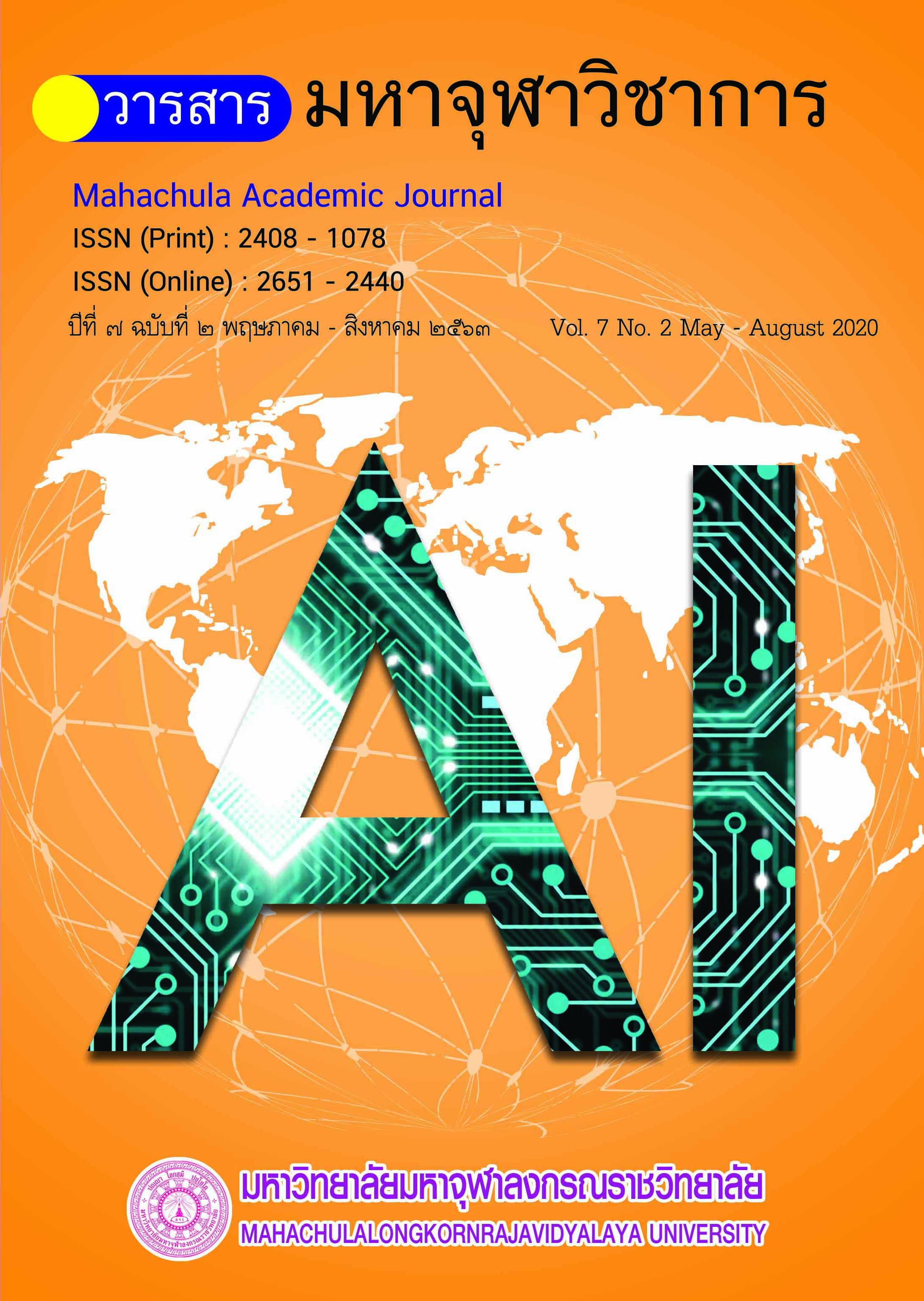พฤติกรรมการใช้สื่อสังคมออนไลน์ ของพระนิสิตระดับปริญญาตรี มหาวิทยาลัยมหาจุฬาลงกรณราชวิทยาลัย อำเภอวังน้อย จังหวัดพระนครศรีอยุธยา
Main Article Content
บทคัดย่อ
จังหวัดพระนครศรีอยุธยา จำนวน ๓๐๘ รูป โดยการสุ่มกลุ่มตัวอย่างแบบไม่ใช้หลักความน่าจะเป็น (Non-probability sampling) ใช้การสุ่มตัวอย่างแบบโควตา (Quota sampling) ผลการศึกษาพบว่า ในด้านพฤติกรรมการใช้สื่อสังคมออนไลน์ของกลุ่มตัวอย่างใช้งานสื่อสังคมออนไลน์มากกว่า ๑ ประเภท โดยเฟซบุ๊กมากที่สุด เข้าใช้งานครั้งละมากกว่า ๓ ชั่วโมงต่อวัน วัตถุประสงค์ในการใช้งานเฟซบุ๊ก คือ เพื่อเปิดรับข่าวสารผ่านสื่อสังคมออนไลน์ และสำหรับการเข้าใช้งานเว็บไซต์ธรรมะ ส่วนใหญ่จะเข้าเว็บธรรมะทั่วไปโดยไม่ได้เจาะจงเว็บไซต์ใดเว็บไซต์หนึ่ง เข้าใช้งานครั้งละ ๓๐ นาที - ๑ ชั่วโมงต่อวัน ผลการศึกษาในด้านการใช้ประโยชน์จากสื่อสังคมออนไลน์ มีค่าเฉลี่ยรวมอยู่ที่ ๔.๒๘ หรืออยู่ในระดับมากที่สุดโดยหัวข้อย่อยใช้สำหรับค้นหาความรู้เพิ่มเติม มีค่าเฉลี่ยอยู่ที่ ๔.๔๐ ผลการศึกษาในด้านการเผยแผ่ธรรมะผ่านสื่อสังคมออนไลน์มีค่าเฉลี่ยรวมอยู่ที่ ๓.๗๕ หรืออยู่ในระดับมาก โดยหัวข้อย่อยการแชร์หัวข้อธรรมะข้อคิดต่าง ๆ มีค่าเฉลี่ยอยู่ที่ ๓.๘๒ ผลการศึกษาในด้านผลกระทบจากการใช้สื่อสังคมออนไลน์มีค่าเฉลี่ย
รวมอยู่ที่ ๒.๒๗ หรือในระดับน้อย โดยหัวข้อย่อยเสียสุขภาพ มีค่าเฉลี่ยอยู่ที่ คือ ๒.๓๔ สำหรับผลการศึกษาสมมติฐานในด้านการใช้ประโยชน์จากสื่อสังคมออนไลน์ พบว่าตัวแปร สถานภาพ อายุ และคณะที่ต่างกันมีการใช้ประโยชน์จากสื่อสังคมออนไลน์ไม่แตกต่างกัน ส่วนตัวแปร พรรษา และระดับชั้นที่ต่างกันมีการใช้ประโยชน์จากสื่อสังคมออนไลน์แตกต่างกัน ผลการศึกษาในด้านการเผยแผ่ธรรมะและผลกระทบจากการใช้สื่อสังคมออนไลน์ พบว่าตัวแปร สถานภาพ อายุ พรรษา คณะ และระดับชั้นที่ต่างกันมีการเผยแผ่ธรรมะและผลกระทบแตกต่างกัน
Article Details
เอกสารอ้างอิง
โกวิท รพีพิศาล. ระเบียบวิธีวิจัย. กรุงเทพมหานคร : มหาวิทยาลัยรังสิต, ๒๕๕๙.
ธนิพร จุลศักดิ์. การเผยแผ่ธรรมะผ่านสื่อสังคมออนไลน์ ของพระมหาวุฒิชัย วชิรเมธี. กรุงเทพมหานคร : มหาวิทยาลัยธุรกิจบัณฑิตย์, ๒๕๕๕.
พระฏุลากาญ กิตฺติคุตฺโต (วิชัย). “สื่อใหม่กับการเผยแผ่พระพุทธศาสนาในยุคปัจจุบัน”. วารสารวิชาการ สถาบันพัฒนาพระวิทยากร. ปีที่ ๑ ฉบับที่ ๒ (กรกฎาคม-ธันวาคม ๒๕๖๑): ๑๑๖.
เมธี เชษฐ์วิสุต. “สื่อสังคมออนไลน์กับการเผยแผ่พระพุทธศาสนา”. วารสารพุทธศาสตร์ศึกษา. ปีที่ ๑๐ ฉบับที่ ๒ (กรกฎาคม-ธันวาคม ๒๕๖๒): ๕๒๕.
สำนักงานพัฒนาธุรกรรมทางอิเล็กทรอนิกส์. รายงานผลการสำรวจพฤติกรรมผู้ใช้อินเทอร์เน็ตในประเทศไทยปี ๒๕๖๑. พิมพ์ครั้งที่ ๑. กรุงเทพมหานคร : กระทรวงดิจิทัลเพื่อเศรษฐกิจและสังคม, ๒๕๖๒.
อรุณรัตน์ ศรีชูศิลป์. “พฤติกรรมการใช้สังคมเครือข่ายออนไลน์ ของนักศึกษาปริญญาบัณฑิตคณะ ครุศาสตร์ ศึกษาศาสตร์ ในมหาวิทยาลัยของรัฐ”. บัณฑิตวิทยาลัย: มหาวิทยาลัยศิลปากร, ๒๕๕๔.
อมรรัตน์ วงศ์โสภา, เสกสรร สายสีสด และแน่งน้อย ย่านวารี. “พฤติกรรมการใช้และผลกระทบของสื่อ สังคมออนไลน์ประเภทเฟซบุ๊คต่อการดำเนินชีวิตของนักศึกษา กรณีศึกษามหาวิทยาลัยราชภัฏเลย”. วารสารวิจัยและพัฒนา มหาวิทยาลัยราชภัฏเลย. ปีที่ ๑๐ ฉบับที่ ๓๓ (กรกฎาคม-กันยายน ๒๕๕๘): ๕.


